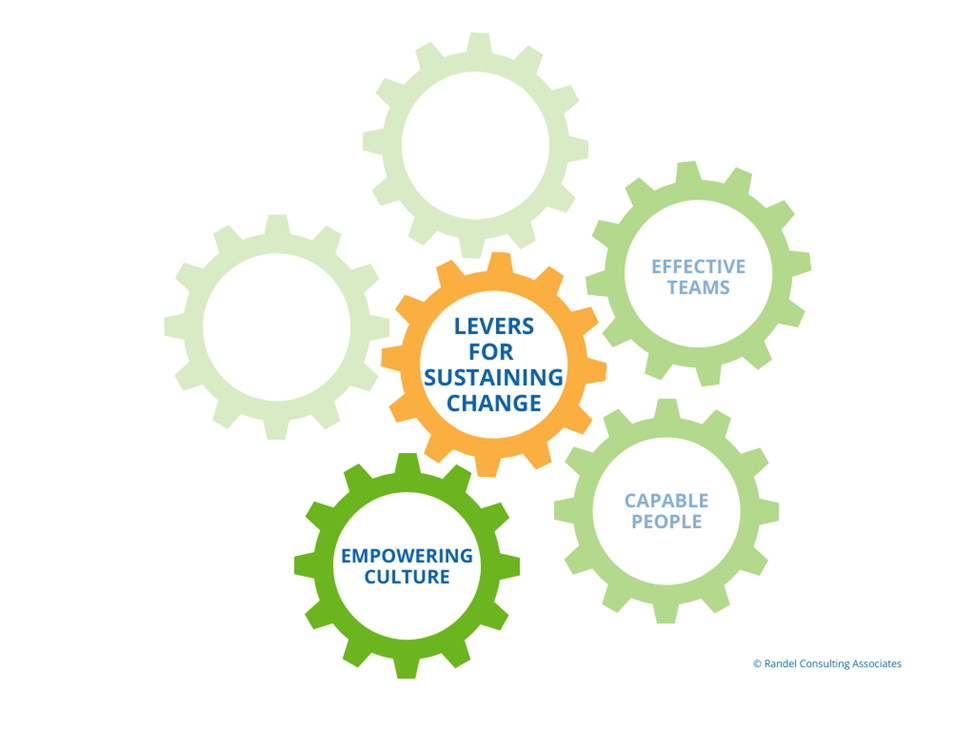What one thing might pose the greatest risk to your change initiative? What one thing, if oriented in the desired direction, can serve as a lubricant that supports and enables the other elements of the RCA Levers for Sustaining Change to interact in ways that propel forward momentum?
In this newsletter series, we are introducing the RCA Levers for Sustaining Change as a way of looking at five interlocking elements that will keep you moving forward and maintaining the processes and impact of change.
We have previously introduced Effective Teams and Capable People as two critical levers. Now, it’s time to meet the third lever!
When you think of workplace culture, what comes to mind? Is it an environment of inclusion, support, collaboration, and mutual respect? Or is it one where micromanagement, favoritism, burnout, and high turnover are rife?
Culture is the heartbeat of your organization. It’s not just about rules and procedures; it’s about how we roll, how we treat each other, and the vibes we bring to the office.
Would you like a quick assessment of your workplace culture? Ask yourself, “How do I feel on a Sunday evening as I think about being at work on Monday?” Do you eagerly anticipate connecting with your colleagues and working on meaningful projects? Or do you dread developing a case of the “Monday Blues”? This simple reflection can bring you insight into how the culture contributes to bringing about and sustaining change in your workplace.
Your workplace culture is like your personal brand – it’s something you want to proudly show off to your friends and connections. Would you invite people from your network to be a part of your company, or would you give them a friendly warning to look elsewhere for career opportunities?
So, what makes for an empowering culture?
In some of my recent work with clients, I’ve come to a deeper appreciation of how Diversity, Equity, Inclusion, and Belonging (DEIB) offers us a helpful perspective on the experience and impact of workplace culture. Let’s have a closer look…
Diversity: This work involves taking a hard, honest look at the workforce and vendor network. Who works here? At what levels are they working? When we identify places where we lack diversity in people, when our ‘About Us’ page does not look like the community we are part of and the clients we serve, we will need to take action—setting hiring targets, expanding outreach in recruitment, and working for more diverse representation. This work is the organization’s responsibility; it’s too structural to be changed by individual actions.
Equity: We turn the spotlight on whether there is equity (which is not the same as equality!) in how people are treated and how they are compensated, developed, and promoted. It means identifying and tackling gender and racial pay gaps and providing the support needed for everyone to shine. This too is organizational work, tackling the systems and structures that created and maintained inequity.
Inclusion: This is where we are all involved! It’s about how we treat each other and how we behave together (especially when away from the public eye). Leaders play a vital role in modeling the behaviors that promote inclusion, but everyone’s behavior counts. It’s about creating an environment where everyone feels valued and heard.
Accessibility: Let’s make sure everyone can join in and contribute equitably. Remove barriers, whether they impact race, gender, or those with (visible and invisible) disabilities, and make participation and contributions easy for all.
Belonging: This is where everyone feels like they’ve found their place, that they are welcome, included, and valued. It’s about experiencing a welcoming, comfortable atmosphere. Unlike the four elements above, this is not measured in organizational action or individual behavior. It can only be assessed as being present by those people who have been marginalized and excluded in the past. Has their experience of being in the organization shifted? Do they experience a greater sense of belonging across all parts of the organization?
This description might feel too conceptual. So let’s use a metaphor to find an easier way to grasp what this truly means—perhaps that of a dinner party (and yes, you’re correct—this is not original to me!)…
Diversity: We look at who is usually invited, and then we take care to broaden the invitation by bringing in those we have ignored or overlooked in the past.
Equity: We cater to all dietary preferences, making sure everyone will find the meal to their liking.
Inclusion: It’s not just about sitting at the table; it’s about being an active part of the conversation.
Belonging: It’s all about how diverse individuals feel as guests. Do they feel valued, heard, and understood? Are their needs being considered?
Cultivating an Empowering Culture is more than just a buzzword—it’s a way of life. The culture sets the tone for your organization’s success and your team’s well-being. It’s the difference between a place where employees thrive, innovate, and stay for the long haul, and one where they merely exist, counting down the days until the weekend (or retirement). By embracing the principles of DEIB—Diversity, Equity, Inclusion, and Belonging— as a guide for this work, you’re not just creating a culture; you’re fostering a community where every individual feels respected, valued, and empowered.
Until next time,

Learn more about the other levers: Effective Teams, Capable People, Hybrid Mastery and Adaptive Leadership


